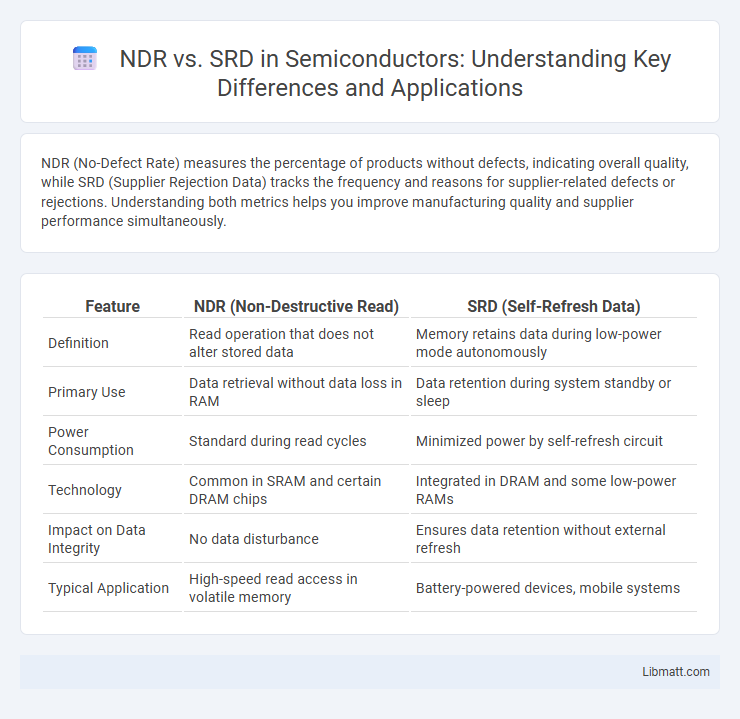NDR (No-Defect Rate) measures the percentage of products without defects, indicating overall quality, while SRD (Supplier Rejection Data) tracks the frequency and reasons for supplier-related defects or rejections. Understanding both metrics helps you improve manufacturing quality and supplier performance simultaneously.
Table of Comparison
| Feature | NDR (Non-Destructive Read) | SRD (Self-Refresh Data) |
|---|---|---|
| Definition | Read operation that does not alter stored data | Memory retains data during low-power mode autonomously |
| Primary Use | Data retrieval without data loss in RAM | Data retention during system standby or sleep |
| Power Consumption | Standard during read cycles | Minimized power by self-refresh circuit |
| Technology | Common in SRAM and certain DRAM chips | Integrated in DRAM and some low-power RAMs |
| Impact on Data Integrity | No data disturbance | Ensures data retention without external refresh |
| Typical Application | High-speed read access in volatile memory | Battery-powered devices, mobile systems |
Introduction to NDR and SRD
Network Detection and Response (NDR) systems focus on monitoring and analyzing network traffic to identify and mitigate cyber threats by detecting anomalies and suspicious activities in real time. Security Response and Detection (SRD) platforms combine threat detection with automated response capabilities to streamline incident management and reduce reaction time during security breaches. Both NDR and SRD play crucial roles in enhancing organizational cybersecurity posture by addressing different layers of threat detection and response.
Defining Network Detection and Response (NDR)
Network Detection and Response (NDR) is a cybersecurity technology that continuously monitors network traffic to detect and respond to threats in real time. NDR uses advanced analytics, machine learning, and behavioral analysis to identify unusual patterns and potential intrusions across network environments. Its proactive threat detection capabilities complement Security Information and Event Management (SIEM) solutions by providing deeper visibility into network activities and enabling faster incident response.
What is Security Risk Detection (SRD)?
Security Risk Detection (SRD) identifies potential threats and vulnerabilities within an organization's digital infrastructure by continuously monitoring for suspicious activities and anomalies. SRD leverages advanced algorithms, machine learning, and real-time data analysis to detect risks before they escalate into security breaches. Your ability to proactively address these threats enhances overall cybersecurity resilience and minimizes potential damage.
Core Features of NDR Solutions
NDR (Network Detection and Response) solutions offer advanced threat detection through continuous network traffic monitoring, leveraging behavior analytics and machine learning to identify anomalies in real-time. Key features include automated threat hunting, encrypted traffic inspection, and integration with existing security infrastructures for comprehensive visibility. These capabilities enable rapid incident response and improved threat intelligence compared to traditional SRD (Security Response and Defense) tools.
Key Capabilities of SRD Tools
SRD tools excel at automated data correlation, real-time threat detection, and comprehensive incident response orchestration, enabling faster identification and mitigation of security risks. Their advanced analytics and machine learning capabilities provide deeper insights into attack patterns, enhancing your organization's proactive defense measures. Integration with diverse security products ensures seamless workflow automation and improved efficiency across security operations.
NDR vs SRD: Main Differences
NDR (Network Detection and Response) focuses on monitoring network traffic and identifying threats within network communications, while SRD (Security Response and Detection) emphasizes a broader approach combining threat detection with incident response across multiple security layers. NDR uses advanced analytics and machine learning to detect anomalies in real-time network data, whereas SRD integrates detection capabilities with automated or manual response actions to contain and remediate security incidents. Understanding the distinction between NDR and SRD helps your organization implement more precise and effective cybersecurity strategies tailored to network-level threats versus comprehensive security operations.
Use Cases: When to Choose NDR or SRD
Network Detection and Response (NDR) is ideal for organizations seeking advanced threat detection through continuous network traffic monitoring and behavior analysis, especially in environments with complex, distributed architectures requiring real-time anomaly detection. Security Risk Detection (SRD) is better suited for assessing vulnerabilities and potential risks within a system, prioritizing remediation efforts based on risk scoring, commonly utilized during compliance audits and risk management processes. Selecting NDR focuses on proactive threat identification and response on the network level, while SRD emphasizes vulnerability assessment and risk mitigation across IT assets.
Integration with Existing Security Infrastructure
NDR (Network Detection and Response) integrates seamlessly with your existing security infrastructure by leveraging network traffic data for enhanced threat detection without requiring endpoint agents, reducing deployment complexity. SRD (Security Response and Detection), often endpoint-centric, depends heavily on agents installed on devices, which can sometimes complicate integration and increase resource consumption. Organizations benefit most from combining NDR's network visibility with SRD's endpoint insights to create a comprehensive, layered security approach.
Challenges in Deploying NDR and SRD
Deploying Network Detection and Response (NDR) faces challenges such as high false positive rates and complex integration with existing security infrastructures, which demand advanced tuning and skilled personnel. Security Response and Detection (SRD) struggles with real-time threat identification and automated response accuracy, often hindered by incomplete data visibility and evolving attack techniques. Both technologies require continuous updates and comprehensive threat intelligence to effectively detect and respond to sophisticated cyber threats.
Future Trends in Network and Risk Detection Technologies
Emerging trends in Network Detection and Response (NDR) and Security Risk Detection (SRD) emphasize the integration of artificial intelligence and machine learning to enhance threat identification and response times. The adoption of behavioral analytics and real-time data correlation improves the accuracy of detecting sophisticated cyberattacks and insider threats. Cloud-native architectures and automation are driving scalability and efficiency in deploying NDR and SRD solutions across hybrid and multi-cloud environments.
NDR vs SRD Infographic

 libmatt.com
libmatt.com